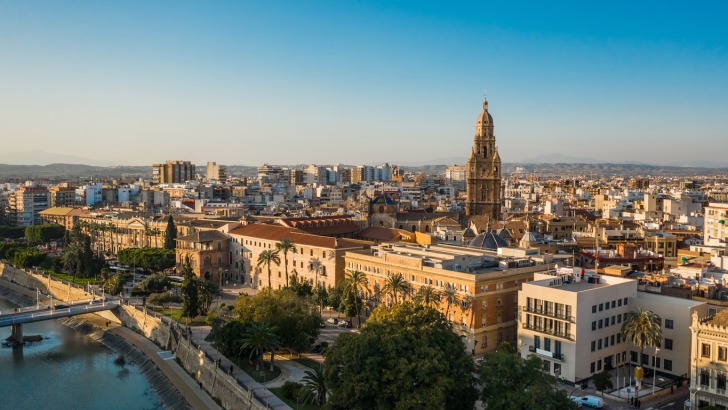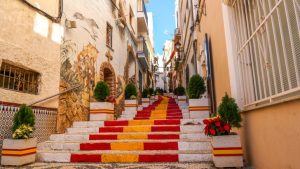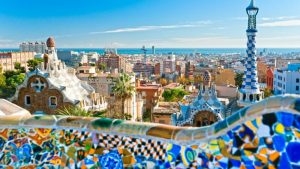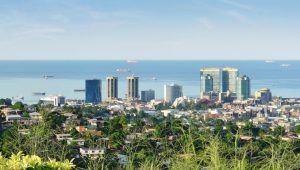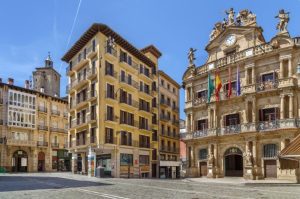 Spain : Safety by City
Spain : Safety by City
- Alicante
- Andorra la Vella
- Barcelona
- Bilbao
- Cadiz
- Canary Islands
- Granada
- Ibiza
- Las Palmas
- Madrid
- Malaga
- Murcia
- Palma de Mallorca
- Pamplona
- Salamanca
- San Sebastian
- Seville
- Valencia
- Zaragoza
Murcia, Spain is a city with 450,000 residents.
This makes it a large city by Spanish standards.
It’s located in the southeast of Spain.
Although it is still not far from the coast.
It is probably best known for being a university town, as well as an agricultural zone or Huerta.
This makes it famous for vegetables and fruit.
While much of this produce is exported throughout Europe, locals also enjoy the benefits of this produce.
It is also renowned for its festivals and churches from the baroque era.
Spain is divided into 17 autonomous communities, with Murcia being the capital of the Murcia Region.
With all that said, it is a safe city to visit, and visitors have few issues.
It is a relaxed city with ample to offer travelers.
Warnings & Dangers in Murcia

OVERALL RISK: LOW
The overall risk to travelers in the area is low. Use common sense about protecting yourself and your belongings and everything will be fine. Many young travelers find the area safe for them while they are studying and enjoying the city and all that it offers.

TRANSPORT & TAXIS RISK: LOW
Transportation including taxis, buses and trams are inexpensive and plentiful. For instance, a bus or tram ticket costs €1.05. All of these forms of transportation are safe and efficient. If you are staying a while, you can purchase a Murcia Bono for €15 which covers 32 trips on the bus or tram. For €20 a pass will cover unlimited trips for a month. Also, bike travel is another affordable, safe option for traveling around the city. Bike rentals are available throughout the city.

PICKPOCKETS RISK: LOW
As with any midsized or large city there is always a risk of pickpockets. In Murcia, the risk is relatively low. Protect your wallet, handbag and any other possessions and you should be fine. Be careful of people bumping into you, as this can be a sign of a pickpocket. Many men carry their wallets in their front pants pocket or inside their coat pocket for protection. For women, there are also small bags available that can be strapped to the bra to protect cash. It’s a good investment.

NATURAL DISASTERS RISK: LOW
The risk of natural disasters in the area is low. Always heed public warnings, but with little rain in the area, the risk of natural disasters is not great for flooding or mudslides.

MUGGING RISK: LOW
This is the same as the pickpocket risk. It can happen, but the occurrence is low. Take steps to protect yourself and there shouldn’t be any problems. If you do have a problem, report it promptly to the authorities. Overall, the level of crime overall is low. The crime index is low, the level of crime is low, the safety index is moderate, and aggressive violent crimes are low. Walking during the day is safe. Walking at night has a moderate risk. That being said, corruption and bribery is a pretty high risk.

TERRORISM RISK: LOW
The risk of terrorism is low. Murcia is a safe, laid-back city. The people are friendly and helpful.

SCAMS RISK: LOW
The risk of scams is also low but always be careful when making purchases or people who approach you for money or a “deal”. This is a larger city but not something that you should expect. Again, be aware of your surroundings and the people you interact with on the street.

WOMEN TRAVELERS RISK: LOW
Women are safe when traveling to this city. Again, be prudent and take the necessary precautions and there shouldn’t be any issues. While it may be safe to walk during the day, take steps to protect yourself. Don’t display expensive jewelry or other items that someone might want to steal. Petty theft can happen even in crowded places. In the city center, the streets are well lighted at night and many people stay up late, so there will always be others around. Avoid any dimly lit areas or those without people around. Public transportation is very safe, but it operates less late at night, so this can be another concern. Another issue that solo women travelers often face is street harassment. This is low in Murcia but may occasionally occur at night when people are out drinking and partying. Even then, it is unusual.

TAP WATER RISK: LOW
The water treatment in Murcia is well-developed. Water goes through filtration, disinfection, coagulation and flocculation (chemical treatments), sedimentation to remove any small particles, then another round of filtration. The water is safe to drink in Murcia and is considered to be high quality. There is a very low risk of having any issues with the water.
Safest Places to Visit in Murcia
The city was founded in 831 by Abd-Al-Rahman.
The city itself is located in the Segura River Valley.
Many remnants of Moorish rule can still be seen, including the old city wall.
There are also many churches in the baroque style to be seen.
- Plaza Santo Domingo – This is the city center and the most recommended place to visit. There are restaurants, bars, tapas and banks. Also, the architecture is a must see. The beautiful Murcia Cathedral is also located there. Don’t miss the museum inside. Meanwhile, spend time just relaxing in the park and enjoying your time there. It’s a lovely place to people watch.
- The Tontodromo – This is adjacent to the center plaza. It also has many restaurants and bars to choose from. Just walking in this area will give you a real feel for the city.
- Leisure Facilities – Though many of them are located on the outskirts of town. Examples include El Tiro, Zig Zag, Thader and the Nueva Condiminia. They are easily reachable by tram.
- Monte Agundo – From this location, you can see the whole of the city. Also, visible is the Christ statue on the mountain. The ruins of a castle stand in front of the Christ statue. This is all visible from this location.
- The Roman Museum – Located behind Plaza Santo Domingo, is a place to see excellent exhibitions.
- Plaza Fuensanta – This is located on Murcia’s Gran Via. This is a shoppers’ paradise. The famous El Corte Ingles is also located there. Shopping here includes well-known designers such as Zara, Massimo Dutti, H&M, Guess, Mango and many others. The plaza is also a great place just to relax. The Murcia pier is also located nearby. You can travel there by Gran Via or Plaza Santo Domingo.
- Thursday Market – Two markets not to miss are the ones at La Fama and Juan Carlos. These are held on Thursdays. You’ll find a wide array of inexpensive items including fresh ingredients, clothing and shoes. You may find the perfect thing to bring home as a memory of your trip and exploration.
Places to Avoid in Murcia
While most of the city is very safe, there is one neighborhood that stands out as one to avoid, and that is Lo Campano.
This neighborhood has developed a reputation for high crime.
There is also poor transportation available in the area.
Other areas known to have high crime rate include San Antolin and El Espiritu.
These areas are known for high drug activity and should be avoided.
These neighborhoods are also known for their poor living conditions.
Safety Tips for Traveling to Murcia
- Pack warm clothes – Spain has more colder periods than warm ones, even though it is known for sun drenched beaches. Most recommend carrying a jacket with you until mid-June. Spring (March-May), fall (September – November) and winter (December – February) can be cold and chilly.
- Mealtimes are later – This can be concerning for travelers who don’t want to be out late at night. Restaurants open for lunch, usually around 1-4 pm. While dinner starts at 8 pm and runs to 1 am. Tapas are the perfect way to stave off hunger in between meals. Many tapas bars include them for free with the purchase of a drink. Also, expect to stay late after dinner for conversation as this is the Spanish custom. Abruptly leaving will mark you as a tourist.
- Bring your credit cards – Many places will accept both cash and credit cards but prefer cards. This goes for restaurants, taxis, bus fares and drink tabs. If you do decide to use cash for some things, be sure to have coins with you, as taxis in the morning will often not have change for bigger bills.
- Tipping is not expected – This may seem unusual, but it is part of the culture. However, if you receive exceptional service, a small tip will be appreciated.
- Don’t eat on the run – This is considered rude by most Spaniards. Walking down the street with a sandwich in hand is considered gauche. This includes eating on public transportation or in taxis.
- Drinks that will highlight that you are a tourist – For instance, sangria is a drink that is meant to be shared at the table among friends and is not an individual drink. If you are alone, consider a glass of wine or beer. A favorite alternative to sangria is tinto de verand. This is a combination of red wine and lemon soda. Understanding these cultural differences can help keep you safe from being identified as a tourist.
- Your personal belongings – Always keep a close eye on your personal belongings. At all times. While crime, including petty theft, is low, it’s better to be safe than sorry. This includes placing your phone, wallet or purse on the table. Be careful of vendors who get too close to you with trinkets or flowers. Your items may disappear.
- Dress appropriately – While you may enjoy visiting the nearby beach, be sure to change before going sightseeing. If you plan on visiting cathedrals, it is appropriate to cover your shoulders and knees when entering these locations. This shows respect. Being dressed provocatively is not a good thing in these locations.
- Learn a few words of basic Spanish – This is not only courteous, but it can also help you in many situations. You don’t have to be fluent, but it doesn’t hurt to know a few phrases. People will appreciate your effort at communicating in their language.
- Common politeness – Greeting people on the street is very common. This also includes shops, hallways and elevators. If someone has been very helpful, the phrase “muy amable” or very kind is a polite way to show some appreciation for their assistance. It can be used in situations as simple as someone holding a door for you or giving directions. This is all about being polite.
- Leaving a party or gathering – Another polite act is to be sure to let your host know that you are leaving. This may be a drawn out process, but again, it shows politeness.
- Emergency Number – If you have an emergency, the number to call is 112. You will be able to connect with multilingual operators to help you.
So... How Safe Is Murcia Really?
Very safe.
While you should still take precautions, most travelers don’t experience any issues at all.
Protect your personal items, be aware of where you are and the people that are around you.
Common sense steps will keep you safe during your visit.
How Does Murcia Compare?
| City | Safety Index |
|---|---|
| Murcia | 83 |
| Madrid | 68 |
| Barcelona | 67 |
| Andorra la Vella | 89 |
| Valencia | 69 |
| Seville | 71 |
| Bilbao | 52 |
| Cordoba (Argentina) | 61 |
| Toronto (Canada) | 81 |
| Melbourne (Australia) | 80 |
| Montreal (Canada) | 81 |
| Sydney (Australia) | 80 |
| Santiago de Chile (Chile) | 71 |
Useful Information

Visas
British citizens don’t need a visa to enter Spain. They are required to have a valid passport. The same is true with American travelers, who will be allowed to enter for 90 days. The same is true for many other countries travelers come from.

Currency
The Euro is the currency used in Spain. There are usually currency exchange places in the airport, but you may not get the best rate. The best option is to get a small amount of cash, then find a better rate at a place in the city.

Weather
The weather is usually comfortable although somewhat hot in summer, we recommend using a high-SPF sunscreen.

Airports
Region de Murcia International Airport serves the area with most major airlines. Another option is Alicante Airport, which has a larger choice of domestic and international flights. They also service low-cost airlines. This airport is located an hour away from the city.

Travel Insurance
This is highly recommended for your trip. Look for a comprehensive policy that will not only cover the trip but also provide medical coverage. Be sure to know exactly what the policy covers and what it won’t. This can save you a lot of problems.
Murcia Weather Averages (Temperatures)
Average High/Low Temperature
| Temperature / Month | Jan | Feb | Mar | Apr | May | Jun | Jul | Aug | Sep | Oct | Nov | Dec |
|---|---|---|---|---|---|---|---|---|---|---|---|---|
| High °C | 17 | 18 | 21 | 24 | 27 | 31 | 34 | 34 | 30 | 26 | 20 | 18 |
| Low °C | 6 | 7 | 9 | 11 | 15 | 19 | 21 | 22 | 19 | 15 | 10 | 7 |
| High °F | 63 | 64 | 70 | 75 | 81 | 88 | 93 | 93 | 86 | 79 | 68 | 64 |
| Low °F | 43 | 45 | 48 | 52 | 59 | 66 | 70 | 72 | 66 | 59 | 50 | 45 |
Spain - Safety by City
| City | Safety Index |
|---|---|
| Alicante | 77 |
| Andorra la Vella | 89 |
| Barcelona | 67 |
| Bilbao | 52 |
| Cadiz | 74 |
| Canary Islands | 81 |
| Granada | 58 |
| Ibiza | 82 |
| Las Palmas | 74 |
| Madrid | 68 |
| Malaga | 76 |
| Murcia | 83 |
| Palma de Mallorca | 57 |
| Pamplona | 81 |
| Salamanca | 59 |
| San Sebastian | 56 |
| Seville | 71 |
| Valencia | 69 |
| Zaragoza | 79 |
